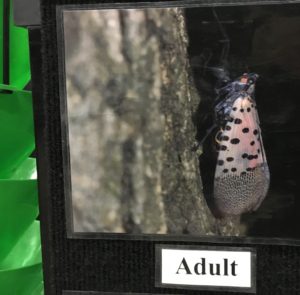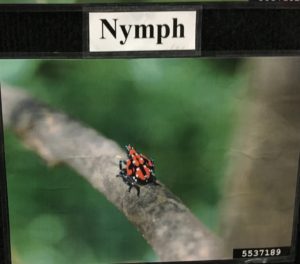Hello fellow readers, Just recently, there’s been two sightings of the dreaded Spotted Lanternfly (SLF) in New Jersey, a topic of great concern at the NJ Plants Trade Show held in Edison, NJ on January 31st, 2018.
“It’s a very bad bug,” stressed Paul Kurtz, Entomologist of the NJ State Department of Agriculture (NJDA). Many folks on the Delaware River’s PA side have seen them swarming cars, gas station walls, and farm fields. Since the first documented sighting in 2014 outside of Philadelphia, they have exponentially multiplied and infested eastern Pennsylvania. In fact, thirteen counties are quarantine areas, which mean no lumber, firewood, construction or plant debris, nursery stock, or cut trees, for example, should be moved out of the quarantined counties.
Paul Kurtz explained that NJ’s first reported finding was an adult Lycorma delicatula found in leaf litter on a grain farm in Asbury (Warren County). The second sighting was nymphs found on a Christmas tree inside a home in Alpha NJ, just outside of Phillipsburg. “We have been proactively working on this,” Paul explained, diligently searching for evidence of SLF and planning control strategies. The current and potential impact across industries such as orchards, vineyards, grain farms, and nurseries is enormous. There was talk at the NJ Plants Show that spotted lanternfly might be devastating to horses if ingested in their grain. However, the PA Department of Agriculture awaits research to confirm this concern, per Bonnie McCann, Communications Director.
In their countries of origin, China, India, and Vietnam, they have natural predators and pathogens that control the populations. Not so here. The phloem-feeding bug with piercing mouthparts sucks branches of plants, including hardwood and fruit trees, grapes, blueberries, and hops. In a recent PA State Senate meeting (10/18/17), a Pike County orchard and vineyard owner spoke about his $400,000 revenue loss as each of his seventy acres of grapes only yielded one to a one-and-a-half ton of grapes versus the normal four-and-a-half ton. The farmer explained that while SLF doesn’t yet eat the apples as they do the grapes, they feed on the terminal end growth, which sets the fruit buds for next year.
Primarily a planthopper, though it can fly, the attractive adults are about an inch long with black heads, black-spotted greyish wings, and bodies that appear to have a reddish glow. The wingless nymphs, which hatch in late April to early May, are black with white spots. They lay their eggs from fall until winter, preferably on the non-native invasive Tree of Heaven (Ailanthus altissima). However, any smooth surface such as rocks, cars, trailers, outdoor furniture, RVs, and farm equipment will do, hence the rapid spread across counties that could easily become across states. Each female lays thirty to fifty eggs in each of three egg masses. Whoa!
We all can do our part to prevent the spread by checking for the yellowish-brown waxy egg masses, especially on vehicles before traveling, and removing them by scraping them into a zip lock bag filled with alcohol or hand sanitizer and tossing them in the trash. Be sure to report findings to your state Department of Agriculture. This is a very bad bug, indeed. Garden Dilemmas? Askmarystone@gmail.com
If you spot evidence of Spotted Lanternfly in NJ or PA: Report findings to the Pennsylvania Department of Agriculture by emailing badbug@pa.gov or call 866-253-7189. The NJ Department of Agriculture, Division of Plant Industry number is (609) 406-6939.





